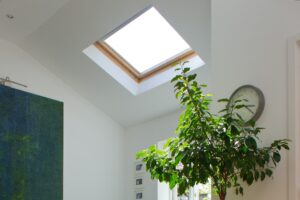 Damp can be a common problem in homes throughout the UK, which may be due to our relatively wet climate. In 2021, the English Housing Survey discovered that over 900,000 homes had issues with damp and mould. This survey found that 11% of the homes with damp issues were in the private rental sector. In comparison to this, only 2% of homes occupied by their owners had similar problems.
Damp can be a common problem in homes throughout the UK, which may be due to our relatively wet climate. In 2021, the English Housing Survey discovered that over 900,000 homes had issues with damp and mould. This survey found that 11% of the homes with damp issues were in the private rental sector. In comparison to this, only 2% of homes occupied by their owners had similar problems.
This comparison sparks an interesting debate. Under the Homes Act, set out in 2018, landlords do have a responsibility to ensure rental homes are ‘fit for human habitation’. This includes making repairs to the structure of the house, drains, and exterior windows.
Whether you are a homeowner or a landlord, it goes without saying that preventing damp should be a priority. Damp and mould issues can quickly spread, causing a deterioration of surrounding structures and furnishings – as well as posing dangerous health hazards. However, when you do not live in the home yourself, how can you ensure the property remains free from damp and mould?
One of the main ways to prevent damp is to make sure the home is properly insulated with quality double glazed windows and doors. Here is our guide on how to ventilate your property and prevent damp.
Why Ventilate Your Home?
Ventilation is essential in controlling the moisture levels within your home. Everyday activities such as cooking, showering, and even breathing release moisture into the air.
The science behind the need for ventilation is simple. When moisture-heavy air is not adequately vented out, it increases the relative humidity levels inside the home. This moisture needs somewhere to settle, so it begins to infiltrate any porous surfaces within your space.
When you notice the tiles in your bathroom are wet after a shower, this is because the droplets have settled on the cold tiles. The same thing happens when moist air settles on other surfaces – but it penetrates porous surfaces such as walls, furniture, and carpets. This leads to damp and mould in the home.
Signs You Need to Ventilate Your Home
High humidity creates an ideal environment for the growth of mould. Humid spaces are also one of the reasons dust mites can become so problematic. Healthwise, damp and mould can trigger allergic reactions, respiratory problems, and worsen asthma symptoms.
Although this is worrying enough, damp conditions and excess moisture within your home can cause more than health symptoms. Damp can lead to several further problems that can become expensive to fix. It can cause structural damage to your property, including rotting wood, peeling paint, and crumbling plaster.
One of the early signs of poor ventilation is condensation appearing on your windows. This often looks like mist or fog that has somehow entered the gap between your windowpanes.
These signs indicate a high level of humidity inside your house. If they are not addressed quickly, condensation can lead to damp conditions. You may also notice a musty smell, or a feeling of stuffiness in your rooms. If this sounds familiar, the humidity levels in your house may be higher than the recommended 40-60%. If these signs are not addressed as soon as possible, they can lead to damp and mould.
How to Ventilate Your Home
Improving ventilation in your home is easier than you might think. Following these tips can help prevent damp from forming in the first place. The tricky part is getting everyone in the house to stick to the same routines.
Here are some practical tips for ventilating the home:
- Fresh Air – You should regularly open doors and windows – weather permitting – to allow fresh air to circulate within your home.
- Effective Airflow – You can create a cross breeze to ventilate the home naturally. This works if you open windows and doors on opposite sides of your house, promoting better airflow through the home.
- Exhaust Fans and Vents – Use exhaust fans in the bathroom and kitchen to extract humid air. Make sure everyone in your home is doing this.
- Keep it Clean – Clean these fans regularly for optimal functioning. Any dust that builds up on fans and vents means the unit cannot work as efficiently as it should.
- Use Dehumidifiers – Dehumidifiers can effectively reduce moisture levels in areas that are prone to damp. These include rooms like bathrooms, utility rooms and kitchens.
READ MORE: 5 Tricks You Hadn’t Thought of to Keep Cool at Home This Summer
Avoiding Sources of Damp
Prevention is better than a cure, and this principle certainly applies to damp. Once damp begins to spread, it can be very difficult to eliminate.
Here’s how you can avoid contributing to damp conditions:
- Laundry – Try not to dry clothes indoors. This can release a significant amount of moisture into your home.
- Showering – Limit shower times and use cold water when possible. This will reduce the amount of steam produced, which means less condensation in the bathroom.
- Cooking – Try to reduce the amount of steam in the kitchen by covering pots and pans on the hob with lids where you can. This can also lead to faster cooking!
- Check for Signs of Damp – Regularly inspect your home for signs of failed double glazing, leaky pipes and ineffective ventilation units. Seek professional repairs if you notice any signs of water infiltration, such as mould or damp around a window, a leaky roof, or cracks in walls.
Repair Faulty Double Glazing to Prevent Damp
If you’ve taken all these precautions, but still find condensation on your double glazed windows, it may be a sign that the sealant on your windows has failed. When this happens, moisture can get trapped between the windowpanes, leading to unsightly condensation.
At Cloudy2Clear, we specialise in replacing failed double glazing, preventing damp and ensuring your windows are as energy efficient as possible. Wherever possible, we replace the windowpane and not the frame. This keeps our services affordable and efficient, with minimal disruption to your home.
Contact us on 0800 61 21 119 today for a free, no obligation quotation.
 Choosing the right double glazing company can make a vast difference to the quality and efficiency of your home’s doors, windows and insulation levels. Double glazing is one of the most effective ways to boost the energy efficiency of your home, so there are plenty of trustworthy traders out there that offer honest, quality installations and repairs.
Choosing the right double glazing company can make a vast difference to the quality and efficiency of your home’s doors, windows and insulation levels. Double glazing is one of the most effective ways to boost the energy efficiency of your home, so there are plenty of trustworthy traders out there that offer honest, quality installations and repairs. Different styles of windows can completely transform the look and feel of any room, with some allowing more natural lighting to enter than others. With certain spaces in the home, various types of windows are also specially designed to offer the most effective solution.
Different styles of windows can completely transform the look and feel of any room, with some allowing more natural lighting to enter than others. With certain spaces in the home, various types of windows are also specially designed to offer the most effective solution. If you are the owner of a listed building, you’ll know just how difficult it can be to make even the smallest of changes for your property. While considering upgrades to your listed building, there are plenty of questions that may spring to mind, most importantly – Can you install double glazing in a listed building?
If you are the owner of a listed building, you’ll know just how difficult it can be to make even the smallest of changes for your property. While considering upgrades to your listed building, there are plenty of questions that may spring to mind, most importantly – Can you install double glazing in a listed building?